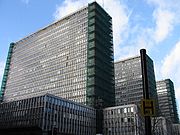
Marsham Towers
Encyclopedia

City of Westminster
The City of Westminster is a London borough occupying much of the central area of London, England, including most of the West End. It is located to the west of and adjoining the ancient City of London, directly to the east of the Royal Borough of Kensington and Chelsea, and its southern boundary...
, London
London
London is the capital city of :England and the :United Kingdom, the largest metropolitan area in the United Kingdom, and the largest urban zone in the European Union by most measures. Located on the River Thames, London has been a major settlement for two millennia, its history going back to its...
. They served as the headquarters of the Department of the Environment
Secretary of State for the Environment
The Secretary of State for the Environment was a UK cabinet position, responsible for the Department of the Environment . This was created by Edward Heath as a combination of the Ministry of Housing and Local Government, the Ministry of Transport and the Ministry of Public Building and Works on 15...
.
Redevelopment
The redevelopment of the site was long planned. The site was originally a gas works and had first included two gas holders (built 1875), renovated in World War 2World War II
World War II, or the Second World War , was a global conflict lasting from 1939 to 1945, involving most of the world's nations—including all of the great powers—eventually forming two opposing military alliances: the Allies and the Axis...
for use as bomb shelter 'citadels' - the North Rotunda and the South Rotunda. A new 'steel-framed building' was also added in 1940–41. The Rotundas were designed to survive the impact of a 500 lb bomb and had 12 feet (3.7 m) concrete roofs. In 1943 the lowest level of the North Rotunda (codenamed Anson) was kitted out as the reserve to the Cabinet War Rooms
Churchill Museum and Cabinet War Rooms
The Churchill War Rooms is a museum in London and one of the five branches of the Imperial War Museum. The museum comprises the Cabinet War Rooms, a historic underground complex that housed a British government command centre throughout the Second World War, and the Churchill Museum, a biographical...
. The previous reserve Paddock
Paddock (war rooms)
Paddock is the codeword for an alternative Cabinet War Room bunker for Winston Churchill's World War II government located in Dollis Hill, North West London under the Post Office Research Station. It was constructed in 1939 but only rarely used during the war, with only two meetings of the War...
in Dollis Hill was seen to be unsatisfactory and too far from Whitehall
Whitehall
Whitehall is a road in Westminster, in London, England. It is the main artery running north from Parliament Square, towards Charing Cross at the southern end of Trafalgar Square...
.
By the early 1960s the increasing numbers of civil servants led to the commissioning of Eric Bedford (1909–2001), Chief Architect for the Ministry of Public Buildings and Works, to design a headquarters building for three separate ministries. His design, published in 1963, placed three twenty-storey slab blocks parallel north to south on top of a three-storey podium slab raised on stilts. Each tower was 66 metres tall and had exposed concrete framing, being built in a new 'box-shell' system which mixed pre-cast concrete and on-site construction.
The towers were completed in 1971 and incorporated the Rotundas in the base. The Rotundas were used as a communications centre and a civil service sports club, amongst other things. By the time the towers were complete, the three separate ministries had merged into the Department of the Environment, and having separate towers proved inefficient. The bland frontage of the blocks, described in Nikolaus Pevsner
Nikolaus Pevsner
Sir Nikolaus Bernhard Leon Pevsner, CBE, FBA was a German-born British scholar of history of art and, especially, of history of architecture...
's architectural guides as "the very image of faceless bureaucracy", was much criticised and local people nicknamed them as "the three ugly sisters".

Michael Heseltine
Michael Ray Dibdin Heseltine, Baron Heseltine, CH, PC is a British businessman, Conservative politician and patron of the Tory Reform Group. He was a Member of Parliament from 1966 to 2001 and was a prominent figure in the governments of Margaret Thatcher and John Major...
announced on 6 February 1992 that he proposed to knock the building down. In 1996 an architectural competition was held for a mixed-use replacement but did not produce a clear outcome. Eventually it was decided to build a replacement for the Home Office
Home Office
The Home Office is the United Kingdom government department responsible for immigration control, security, and order. As such it is responsible for the police, UK Border Agency, and the Security Service . It is also in charge of government policy on security-related issues such as drugs,...
on the site and the towers were taken down in 2002–03. The site is now occupied by Sir Terry Farrell
Terry Farrell (architect)
Sir Terry Farrell, CBE, RIBA, FRSA, FCSD, MRTPI is a British architect.-Life and career:Farrell was born in Sale, Cheshire. As a youth he moved to Newcastle upon Tyne, where he attended St Cuthbert's High School. He graduated with a degree from Newcastle University, followed by a Masters in urban...
's new building at 2 Marsham Street
2 Marsham Street
2 Marsham Street London has been the headquarters of the Home Office, a department of the British Government, since March 2005. Before this date the Home Office was located at 50 Queen Anne's Gate.-History:...
, which the Home Office first occupied in February 2005.

